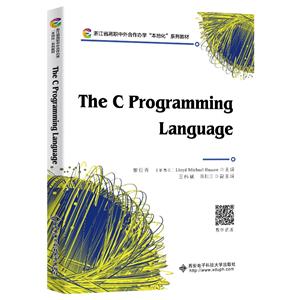-
>
中医基础理论
-
>
高校军事课教程
-
>
思想道德与法治(2021年版)
-
>
毛泽东思想和中国特色社会主义理论体系概论(2021年版)
-
>
中医内科学·全国中医药行业高等教育“十四五”规划教材
-
>
中医诊断学--新世纪第五版
-
>
中药学·全国中医药行业高等教育“十四五”规划教材
The C programming language 版权信息
- ISBN:9787560658773
- 条形码:9787560658773 ; 978-7-5606-5877-3
- 装帧:一般胶版纸
- 册数:暂无
- 重量:暂无
- 所属分类:>
The C programming language 内容简介
There are 12 modules in this textbook, including: C programming overview; types, operators and expressions; input and output; decision making; loops; arrays; functions; preprocessors; pointers; structures, unions and enums; bitwise operators; files. This textbook was developed in response to the growing scale of Sino-Foreign education cooperation and the growing demand for English and bilingual textbooks. It focuses on students participating in English or bilingual classes in higher vocational education, and emphasizes the combination of theory and practice. This textbook provides a variety of resources, such as the Chinese annotation of the corresponding chapters, answers to the exercises, source codes, teaching coursewares, teaching plans and other conventional teaching resources. Students can scan the QR code to gain these resources.
The C programming language 目录
- >
李白与唐代文化
李白与唐代文化
¥10.4¥29.8 - >
伯纳黛特,你要去哪(2021新版)
伯纳黛特,你要去哪(2021新版)
¥15.9¥49.8 - >
姑妈的宝刀
姑妈的宝刀
¥9.6¥30.0 - >
苦雨斋序跋文-周作人自编集
苦雨斋序跋文-周作人自编集
¥6.9¥16.0 - >
二体千字文
二体千字文
¥14.0¥40.0 - >
罗曼·罗兰读书随笔-精装
罗曼·罗兰读书随笔-精装
¥18.6¥58.0 - >
随园食单
随园食单
¥15.4¥48.0 - >
伊索寓言-世界文学名著典藏-全译本
伊索寓言-世界文学名著典藏-全译本
¥6.1¥19.0
-
媒介研究导论
¥58.9¥69.8 -
大学语文
¥21.1¥39 -
古典基督教思想的“自我”观念
¥14.9¥30 -
新世纪高等学校教材 心理学基础课系列教材普通心理学(第5版)/彭聃龄
¥39.2¥78 -
人民邮电出版社态度改变与社会影响(中译本修正版)
¥103.5¥138 -
电工电子实验实训指导
¥24.3¥25


















